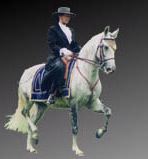 |
classicaldressagescotland.com |
| Lesson 7: On the Bit |
| New web address: www.classicaldressagescotland.com |  |
| About this site | About us | Personal Tuition | Video analysis | Lesson menu | Portugal and Lusitanos |
| Home Schooling Classical dressage Modern dressage Horse trials Show jumping Glossary Links |
Unfortunately, On the Bit is a much
used and abused term. The phrase therefore is somewhat misunderstood
and many riders are confused as to the correct meaning. A better
term would be:
Don't try this at home:Imagine that to test a theory, you were asked to put a bit into a friend's mouth and control him or her (for convenience I'll call your friend her), the same way as you would control a horse. You put the bit, this steel bar, jointed in the middle so that it can crush your friends tongue, into her mouth. You stand behind your friend holding the reins and you give her a nudge in the back to start her walking forward.Your friend would immediately want to raise her head so she could see where she was going. Also she would want to carry the bit in the least tender part of her mouth. The corners of her mouth, her cheeks, the spongy part of the mouth. Your friend would obviously be very interested in what you were going to do with the reins, but you would not have all of her attention. She would go into self-preservation mode. After all, you now have the power to hurt your friend with your hands through the reins. Now ask your friend to lower her head so that the bit is carried on the lower jaw, the most tender part of the mouth, and with her jaw against her chest, impair her vision. Once again, nudge your friend in the back and ask her to walk. Now ask your friend how she feels. Your friend will now be extremely interested in what you were going to do with your hands, and you would most certainly have all of her attention. After all, she cannot see where she is going and if you pull back you will most certainly cause her pain. For your friend to allow you to do this, I suggest, would probably qualify her for immediate entry into a mental institute, but it would also take a tremendous amount of trust and cooperation from your ex-friend just to survive and avoid being hurt. Now you know, or your friend will certainly know how a horse feels. Obviously a horse will not feel the same emotions as a human being and the bit after all has been designed to fit into a horse's mouth. Across the bars of the lower jaw, (the gum between the incisor and molar teeth). But the same fear exists for the horse as for the human. The fear of pain and abuse through the rein. A horse to be 'on the bit' or to have 'acceptance of the bit' he must have total trust and be relaxed with the rider's hands (via the reins) in the mouth and you will have all of his attention. Have you ever wondered why, as riders, we use reins? The reason is simple. Our arms are not long enough to reach the horses mouth. If only our arms were long enough, we could reach forward and hold the bit with our fingers at the horse's mouth or even use each index finger, without a bit, on the bars of the mouth. We would be naturally softer and the aids to the horse's mouth would be a lot more logical and sympathetic. 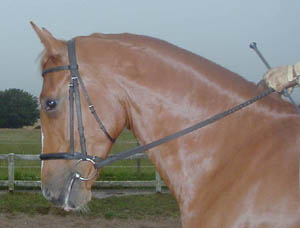 A horse has accepted the bit, is On the Bit if:
The horse is above the bit if his head is held high, the angle of the head is too far in front of the vertical and his back will tend to hollow. The hindquarters are not pushing the horse forward but being left behind and the front legs are pulling the horse forward.
The horse will hold his head low and behind the vertical. This is not a serious fault as long as the horse is not trying to avoid the contact, but is maintaining a light, elastic consistent feel. One man might see that the horse is behind the bit (over bent) but a horseman would see that the horse has not engaged his hindquarters. The Lesson - Or HELP I'm lost and don't know what to do! To truly have a horse on the bit or to have your horse accept the bit will take many months of hard and sometimes frustrating work. See the lesson On The Aids. You must work him in a routine way. Ride him every day if possible. Riding on Monday and then perhaps on Thursday and then wait for a couple of days before riding him again will not build muscle or balance and the horse will not benefit from routine. Horses just love routine. Listen to any yard, stables or barn around feeding time. They know the routine better than the grooms do. You must work on tempo. The horse must always be willing to maintain the rhythm of the gait. Whether it be walk trot or canter. Always work in a tempo. He must be willing to go forward and create impulsion (energy). You must work him in all the school movements. Make him straight, ride circles and transitions, all the time asking him to accept a light hand and be soft in the mouth. If he leans or pulls, work on transitions. Always ask him to seek or look for your hand. You should, as soon as possible, take a light but positive contact with the reins. By keeping the horse calm and in rhythm, using a listening leg and a soft hand but without loosing contact, the rider should soon induce the horse to move forward into the bit. Present him with a contact that you, the rider, would like if the roles were reversed. If your horse pulls on the reins in an effort to go faster, then you should, with many and I really mean many downward transitions and repeated giving and taking the reins make him accept a balance and rhythm on a lighter contact. The sort of feel that you are looking for is that the bit is stuck in a Christmas pudding and if you pull too hard you will pull the bit out of the pudding and you will ruin Christmas for everybody. I know that sounds crazy but if you are really determined and want to train horses, you are half way to a mental institute already! If your horse is above the bit your horse must be worked and exercised to develop a stronger and more rounded back. He will be best worked at the rising trot, or in really bad cases just in walk. Put him into an outline, put your horse on the aids (monthly lesson number 3) and when you have the outline you want, be particularly sympathetic with the feel in your hands. He must bend his poll and relax his lower jaw and stop resisting the contact. The horse should be ridden forward to a rein contact and asked to engage his hindquarters, which will encourage him to round his back and lower his head. Circles are the best way to encourage your horse to accept the outside rein from the inside leg, occasionally opening your fingers or even, for a fraction of a second, giving the inside rein. Use the exercise of spiraling in and out of a circle. Make the circle smaller, say 10 meters, with the outside leg, then make the circle bigger, say 20 meters, from the inside leg and a soft or giving inside rein. Change the rein often. When you feel your horse has stopped pulling on the inside rein, use your inside hand with the inside rein to stroke your horse's neck. This has two benefits. Firstly it rewards the horse for not pulling on the inside rein. Secondly it will prove to you that you do not need the inside rein to bend or turn your horse. If after these exercises your horse has come into an outline but when you make your horse go straight, shall we say, down the long side of the arena, he resists your hands and just lifts his head, this is what you do
To Develop Acceptance of the Bit To achieve this lovely feel of a horse being on the bit, the acceptance of the bit, the rider has to establish a rapport with his horse, feel what's going on under the saddle. Open a channel of communication. Understand your horse's character; be aware of his physical strengths and weaknesses. Give the horse every opportunity to understand. Always reward him if he has done well. To Summarise To achieve physical submission, to be on the bit, your horse must develop impulsion, rhythm and balance, suppleness, straightness and accept the bit, so that he will find it easy to work 'with' the rider and not 'for' the rider. Good luck with this month's lesson. If you have any problems, email me. Its what I'm here for but I will leave this lesson with a saying from Nuno Oliveira; - If a Man knows all things but has no 'feel' - that is disaster
|
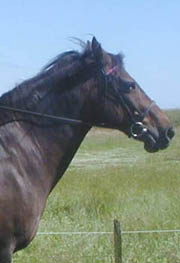 Above the Bit
Above the Bit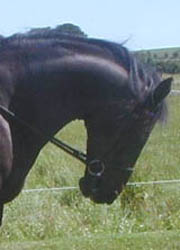 Behind the Bit
Behind the Bit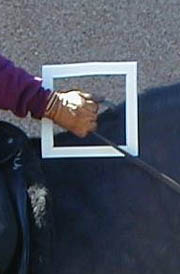 Imagine your hands, holding the reins in the correct
position, in front of the saddle and above the wither, are stuck
in a box. (See picture). Within the box your hands are able to
move and be supple and giving, but if your horse pulls, i.e.
trying to take your hands forward and out of the box, suddenly
your hands hit the side of the box. The box is solid so your
hands cannot move past the confines of the box, your knuckles
have hit the side of the box. The horse will feel this resistance,
this block, this sudden uncomfortable feeling and lower his head
to relieve the pressure of the bit in his mouth. Resistance or
blocking is not pulling (not my words, Nuno Oliveira's). Close
the lower leg at the same time as there is resistance. You must
keep your horse going forward. The blocking must not stop your
horse. As soon as your horse has lowered his head, your hands
are back into the box and can move with sympathy and softness.
Always be careful not to pull your horse's head down with the
reins. Besides being unkind, it will force the hindquarters backwards,
hollow the horses back and create resistance and more problems.
Imagine your hands, holding the reins in the correct
position, in front of the saddle and above the wither, are stuck
in a box. (See picture). Within the box your hands are able to
move and be supple and giving, but if your horse pulls, i.e.
trying to take your hands forward and out of the box, suddenly
your hands hit the side of the box. The box is solid so your
hands cannot move past the confines of the box, your knuckles
have hit the side of the box. The horse will feel this resistance,
this block, this sudden uncomfortable feeling and lower his head
to relieve the pressure of the bit in his mouth. Resistance or
blocking is not pulling (not my words, Nuno Oliveira's). Close
the lower leg at the same time as there is resistance. You must
keep your horse going forward. The blocking must not stop your
horse. As soon as your horse has lowered his head, your hands
are back into the box and can move with sympathy and softness.
Always be careful not to pull your horse's head down with the
reins. Besides being unkind, it will force the hindquarters backwards,
hollow the horses back and create resistance and more problems.